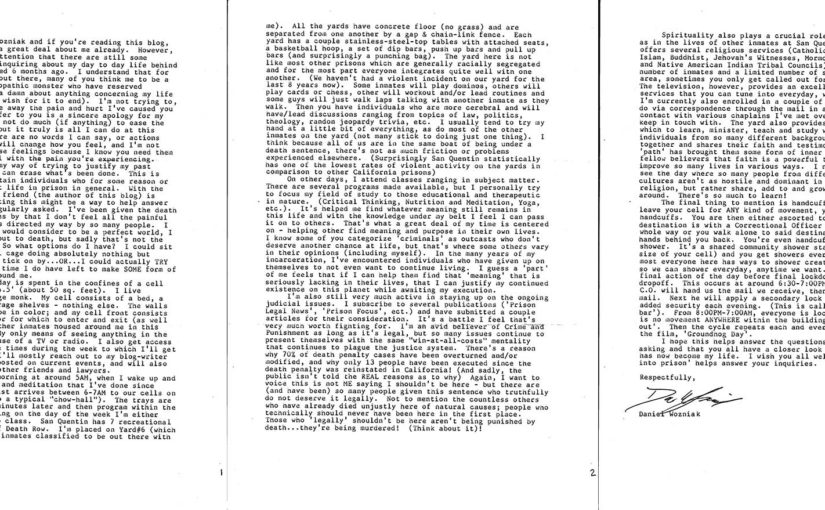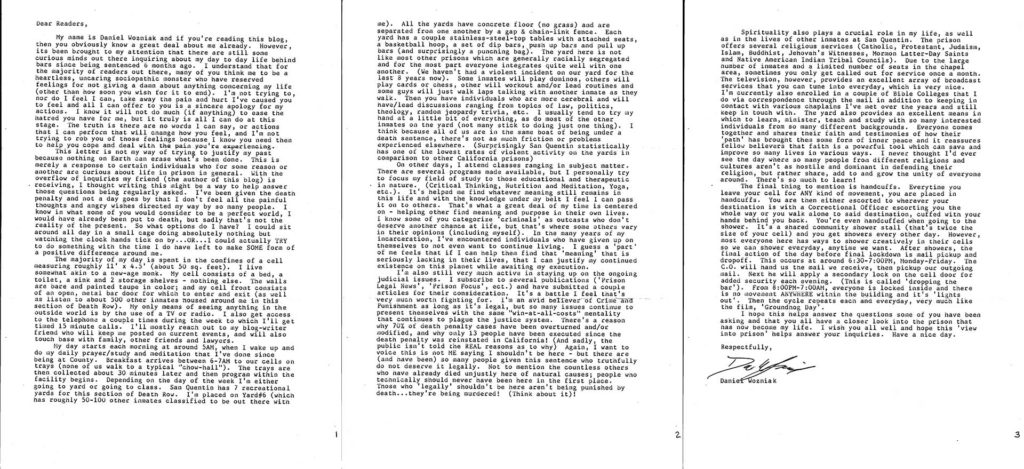Hello readers, and happy new year to you!
Daniel Wozniak started 2022 at a new address.
He was relocated from the Salinas Valley State Prison to the California Medical Facility (CMF) in Vacaville at the beginning of December 2021.
He and at least one other former San Quentin death row inmate made this seemingly lateral move (as far as freedoms and advantages are concerned) for, basically, administrative reasons. They needed to be re-classified.
All the former Death Row inmates were involved in a pilot program moving them to prisons where they could have opportunities to work and earn money at inmate jobs to facilitate paying restitution to the loved ones of their victims. The program was also intended to give DR inmates freedoms and opportunities that are not logistically available at San Quentin.
When the pilot program ended, Daniel and some of the other former SQDR inmates needed to be re-classified. I’ll spare you the minute details of why they couldn’t just be re-classified and stay in Salinas Valley, but they couldn’t… and so they moved again.
As opposed to the huge culture shock of moving from San Quentin to Salinas Valley, CMFV isn’t much of a change, aside from how Daniel says he has an actual window in his cell that is at least “person-sized” and opens up to the outside world.
It appears the pilot program has been successful enough to be put into use with the over five hundred and fifty remaining San Quentin death row inmates. California governor Gavin Newsom recently announced the planned closure of the entirety of San Quentin’s death row within the next two years.
It is the nation’s largest death row, and the only death row in the state of California. So even though the death penalty will still be available as a sentencing option, there won’t be a specific destination to send the condemned.
Personally, I am against the death penalty, but I can understand how losing a loved one to murder could make an individual long for that type of revenge / justice.
How could California’s death penalty hold any real weight for perpetrators or victims without the fear of living the rest of one’s days in that ominous rock fortress known as San Quentin?
Without housing California’s only death row, the prison doesn’t really serve any specific purpose that can’t be fulfilled by more modern prisons in the middle of nowhere. San Quentin is located on a very nice piece of property that could be turned into valuable real estate for the state.
Daniel made a claim that Newsom’s wife is a “land developer,” and it was obvious he was saying that California’s governor was more interested in making money than saving lives.
Daniel was wrong. Jennifer Siebel Newsom is documentary filmmaker, producer, and actress. Maybe the idea of her being a land developer just made for more of an interesting story to pass from inmate to inmate..?
As with the pilot program that included Daniel, the main justification given for moving inmates is less humanitarian and more goal based.
“For the first time in California’s history, eligible death-sentenced individuals may be housed in general population areas where they can have more access to job opportunities enabling them to pay court-ordered restitution to their victims when applicable,” — Vicky Waters, spokesperson for the Department of Corrections and Rehabilitation.
Is Governor Newsom trying to completely abolish the death penalty in California?
In 2019, Newsom did put a moratorium on executions in California for as long as he is the governor, but he talks more of reforming the death penalty, not overturning it.
“We’re one of the few industrial nations in the world that still sentences its population to death,” he said. “I look forward to advancing more leadership on reforming the death penalty here in this state and, hopefully, across the country.”
I have to wonder how many of the men on San Quentin’s death row (and women at Chowchilla) look at this mass relocation as positive or negative. Daniel’s said there weren’t a ton of volunteers willing to join the original pilot program, and he claims two inmates committed suicide just to avoid the possibility of being forced to move in the foreseeable future.
I did find articles about the two suicides, but there was no specific reason given for why the men took their own lives. One of men had only been on death row for a month. The other, since 2004.
Daniel believes the forced closure and re-location of every prisoner on death row will actually lead to numerous inmate deaths, therefore “speeding up” the execution process for a number of cases. He’s positive quite a few of those who have sat for decades on death row will take their own lives before allowing themselves to be moved from the familiarity of their tiny cells.
Daniel, however, is much more comfortable and had freedoms and opportunities he never had at San Quentin. The fact that he may be able to work to pay restitution may be cold comfort for the surviving loved ones of Sam Herr and Julie Kibuishi.



